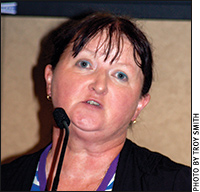SBCW 2016:
Flooring Effects on Cattle Welfare and Performance
Space and flooring type studies aim to inform policy.
by Kasey Brown, senior associate editor
MANHATTAN, Kan. (June 9, 2016) — The European Union (EU) imposes more regulations regarding animal welfare than the United States does, but for beef industries that rely upon export, those regulations are important to follow. Bernadette Earley, principal research officer for the Animal and Bioscience Research Department at the Irish Agriculture and Food Development Authority (Teagasc) Animal & Grassland Research and Innovation Center, said the Irish beef industry exports 72% of its production.

Based on average daily gains and lying behavior, one study reported by Teagasc's Bernadette Earley indicated space of at least 2 square meters per head was the optimal allottment when cattle were housed indoors.
One of the regulations says the minimum space required is 3 meters squared [about 32 feet (ft.) squared] per head for animals expected to reach about 1,100 pounds (lb.), plus or minus half a meter squared (5 ft.) for each 220 lb. expected between 882 lb. and 1,765 lb. [400 kilograms (kg) to 800 kg]. She said there is no clear scientific basis in the literature to justify the plus or minus aspect.
She shared several studies that compared spacial allowances ranging from 1.5 meters squared (about 16 ft. squared) up to 4 meters squared (43 ft. squared), which looked at behavior, performance, stress and immune response. Restricted space, less than 2 meters squared, showed adverse effects in all three areas. More time was spent lying down and eating in larger spaces, with less aggressive behavior. Earley concluded that space at least 2 meters squared was the optimal allotted space when housed indoors based on average daily gains and lying behavior.
Concrete slatted floors are used predominantly in Ireland for winter bedding, and straw bedding isn’t prevalent because there isn’t sufficient supply. Earley said the perception has been that concrete slatted floors are uncomfortable underfoot, and there have been calls to phase out fully slatted concrete floors. Due to the prevalence of these floors, that would leave Irish cattlemen two options: double the amount of housing space or reduce the cattle by half, which are both unsustainable because of already low profit margins.
She shared data from a study looking at the standard space allowance of 2.5 meters squared (27 feet squared) and comparing concrete slatted floors and straw bedding. Welfare and performance were optimized at 3 meters squared per head, but straw had no effect on animal production or immune function, she reported. Lying down was increased on straw, but not a significant amount.
Her last study compared new and old concrete slats, and those covered with rubber mats. Hoof condition was negatively affected with the rubber mats, and cleanliness and hematology showed no effect by floor type. Rubber mats did improve live weight gain and carcass gain. The type of the slats showed no effect on welfare or performance.
She concluded that she hoped these studies would help inform policy makers, especially on underfoot conditions.
Watch for additional coverage of the 2016 ISBCW on www.angus.media and in the Angus Journal and Angus Beef Bulletin. Comprehensive meeting coverage will be archived at www.api-virtuallibrary.com/meetings_other_news.html.
Editor’s Note: The articles used within this site represent a mixture of copyrights. If you would like to reprint or repost an article, you must first request permission of Angus Media by contacting the editor at 816-383-5200; 3201 Frederick Ave., Saint Joseph, MO 64506. Angus Media claims copyright to this we site as presented. We welcome educational venues and cattlemen to link to this site as a service to their audience.
